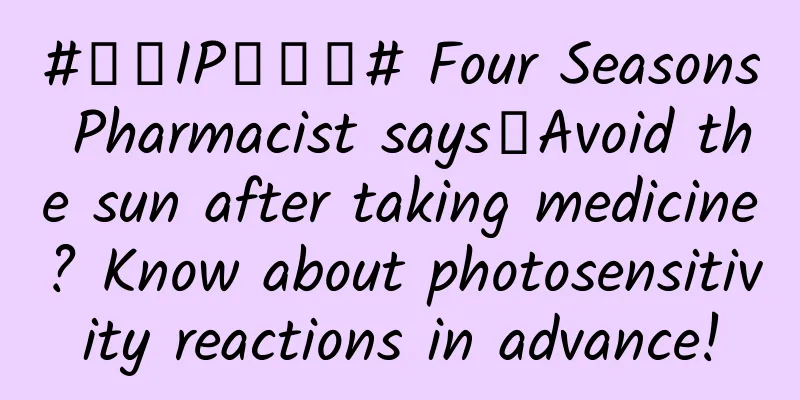#千万IP创科普# Four Seasons Pharmacist says丨Avoid the sun after taking medicine? Know about photosensitivity reactions in advance!

|
With the arrival of summer, in addition to the increase in the number of patients with skin diseases related to seasonal factors such as summer dermatitis, solar dermatitis, papular urticaria, etc., some people also suffer from skin diseases related to exposure to sunlight or ultraviolet rays after taking medicine, which is called drug-induced photosensitivity reaction. Do you know about photosensitivity reaction? Conditions for drug photosensitivity reactions Photosensitivity reaction of drugs refers to an adverse reaction of photosensitivity dermatitis after exposure to ultraviolet rays after using photosensitive drugs. Ultraviolet rays mainly include medium-wave ultraviolet rays with a wavelength of 290 to 320 nanometers (nm) and long-wave ultraviolet rays with a wavelength of 320 to 400nm. Two conditions must be met for drug photosensitivity reaction to occur: the first is the use of photosensitizing drugs, and the second is exposure to a certain amount of sunlight or ultraviolet rays. Classification of drug photosensitivity reactions According to the mechanism of occurrence, drug photosensitivity reactions are divided into phototoxic reactions and photoallergic reactions. Phototoxic reactions are mostly clinically manifested as excessive sunburn-like reactions. Phototoxic reactions can occur in anyone. Generally, they can occur within a few minutes to a few hours after the first use of the drug and exposure to sunlight and similar light sources. The onset occurs on the face, V-shaped area on the chest, limbs and other exposed parts of the skin. The clinical manifestations are similar to solar dermatitis, which is edematous erythema. In severe cases, blisters appear, and there is a burning and stinging sensation. The intensity of the phototoxic reaction is related to the concentration of the photosensitizing drug and the time and intensity of light exposure. After removing the photosensitizer and avoiding light, the reaction subsides quickly. Photoallergy is a delayed allergic reaction, an acquired immune-mediated reaction with a low incidence. In addition to being related to drugs, the occurrence of photoallergy is also related to genetics and allergic constitution. The first onset of photoallergy generally has a latent period of 24 to 48 hours. In addition to occurring on exposed areas, the rash can also spread to non-exposed areas. The clinical manifestations are an eczematous appearance with visible erythema, papules, blisters or exudation, generally without pigmentation. Chronic damage can cause the skin to thicken or lichenify, and some may develop into chronic, persistent photosensitivity reactions. Drugs that can cause photosensitivity reactions (1) Anti-anxiety drugs Alprazolam. (2) Antimicrobial drugs Azithromycin, fluoroquinolones, and trimethoprim-sulfamethoxazole. (3) Acid-suppressing drugs Omeprazole, rabeprazole, pantoprazole and esomeprazole. (4) Antidiabetic drugs Voglibose, glimepiride. (5) Uric acid-lowering drugs Benzbromarone. (6) Antihypertensive drugs Nifedipine, valsartan, irbesartan and hydrochlorothiazide. (7) Antiarrhythmic drugs Amiodarone. (8) Lipid-lowering drugs Fluvastatin, fenofibrate. (9) Diuretics Furosemide, hydrochlorothiazide. (10) Skin medication Loratadine, retinoic acid, promethazine, etc. In addition to Western medicine, some Chinese medicines or plants can also induce photosensitivity reactions, which is called phytophotodermatitis. This type of Chinese medicine includes Chinese medicine containing psoralen and isopsoralen, such as psoralea corylifolia, peucedanum chinense, angelica dahurica, etc. Methoxsalen, a topical drug for psoriasis, is a derivative of psoralen and should be used in accordance with the advice of a dermatologist. Some other Chinese medicines contain photosensitive quinone ingredients, such as St. John's wort (St. John's wort, which is not the same as forsythia), bamboo rhubarb, etc. Vegetables such as coriander, celery, fennel, toon, amaranth, gray vegetables, and fruits such as sweet oranges, lemons, and figs are also photosensitive because they all contain the same ingredient - furanocoumarin. Furanocoumarin is a natural photosensitizer that does not cause damage to the skin itself, but when exposed to ultraviolet rays, it will produce a photosensitive reaction, which will cause the skin to be sunburned. Treatment of photosensitivity reactions For photosensitivity reactions, the first thing to do is to remove photosensitizing substances and avoid light, apply local cold compresses and topical moisturizers; topical glucocorticoid preparations are used for anti-inflammatory purposes. Antihistamines can relieve itching, and in severe cases, glucocorticoids can be taken orally or intravenously. When some photosensitivity drugs must be used, sun exposure should be strictly avoided. The occurrence of photosensitivity reactions can be reduced by shortening the medication time, reducing the dosage of the drug, and applying it before going to bed at night. When exposure to light is unavoidable, you can choose sunscreens that have broad-spectrum protection against ultraviolet rays. Photosensitivity reactions can occur all year round, but they often occur in summer. Patients with a history of phototoxic reactions should use photosensitivity drugs with caution. It is recommended that you read the instructions carefully before using the drug. You must avoid exposure to sunlight or ultraviolet rays during the use of photosensitivity drugs and within 5 days after stopping the drug. If photosensitivity reactions occur, stop taking the relevant drugs immediately and go to the hospital's dermatology department for treatment in a timely manner. |
>>: "Disappeared" for more than half a century! This critically endangered species appears
Recommend
Performance marketing is too difficult
Not wasting a single cent of advertising budget i...
The Taklimakan Desert is getting wetter! Why is rainfall in southern Xinjiang becoming more frequent?
On August 27, the topic #新疆塔克拉玛干漠发Flood# ranked f...
How to evaluate the pros and cons of multiple promotion channels?
I have always wanted to write an article like thi...
Wave power: a treasure of marine resources
Wave power generation is a clean and efficient po...
Programmatic Advertising Quantitative Evaluation Revenue Indicator - eCPM
This article will share with you how to improve &...
A family of five was diagnosed with thyroid cancer one after another. Why did the cancer prevention line collapse completely?
Recently, when a patient was diagnosed with thyro...
How to use Zhihu to effectively attract traffic and promote products?
What kind of platform is Zhihu? To study traffic ...
China's deserts selected as World Heritage Sites: Uncovering the "Five Big Mysteries" of the Badain Jaran Desert
On July 26 and 27, local time, at the 46th UNESCO...
Notice! During the 315 period, advertising must avoid these problems
The closer we get to March 15, the calmer things ...
Google will shut down account login for Android 2.3.7 and earlier versions
[[414551]] According to foreign media 9to5Google,...
Sneezing can cause lumbar fracture! Don’t just drink milk to supplement calcium, there are 7 kinds of vegetables with higher calcium content than milk!
Recently, Ms. Ding, who is over 70 years old, fro...
Is it better to replace the phone than the battery? What should I do if the battery life gets worse?
Mobile phones have become an indispensable part o...
Why did Li Jiaqi and Viya start to develop private domain traffic?
When it comes to Li Jiaqi and Viya, you might thi...
What are the differences among mvc1, mvc2 and mvc3?
mvc1 mode: The view receives user input and passe...
When a person is crying, he starts to "twitch", not because of fear but because of "poisoning"
When we were young, we might be beaten by our par...









